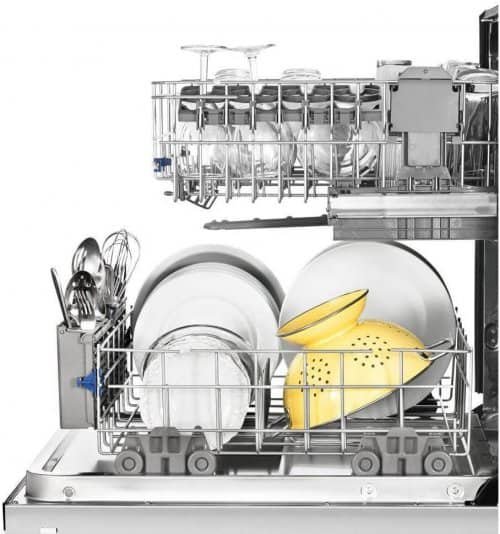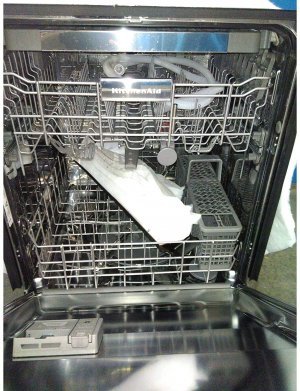Dishwashers are a time-saving and convenient appliance in the kitchen, making it easier to clean dirty dishes and utensils. One important component of a dishwasher is the rinse aid dispenser, which helps to ensure that dishes are left sparkling clean and free of water spots. However, when the rinse aid dispenser is not working, it can lead to dishes that are not as clean or have water spots. In this article, we will explore the reasons why a dishwasher rinse aid dispenser may not be working and what steps can be taken to fix it.
Possible Causes of Dishwasher Rinse Aid Dispenser Not Working
- Clogged Dispenser
Over time, the rinse aid dispenser can become clogged with residue and debris from the dishwasher detergent or food particles. This can prevent the rinse aid from flowing out of the dispenser properly and cause it to malfunction.
- Low Rinse Aid Level
If the rinse aid level in the dispenser is low, it can cause the dispenser to stop working. The dishwasher may be able to detect the low level and prevent the dispenser from functioning properly.
- Dispenser Cap Not Tightened
If the cap on the rinse aid dispenser is not tightened properly, it can cause the rinse aid to leak out and not be dispensed properly.
- Malfunctioning Dispenser
If the above causes are not the issue, it is possible that the dispenser itself is malfunctioning. This could be due to a faulty part or an electrical issue.

Steps to Fix Dishwasher Rinse Aid Dispenser Not Working
- Check Rinse Aid Level
The first step in fixing a dishwasher rinse aid dispenser that is not working is to check the level of the rinse aid. If the level is low, refill the dispenser with rinse aid.
- Clean Dispenser
If the dispenser is clogged, it will need to be cleaned. Remove the dispenser and rinse it thoroughly with warm water. Use a toothbrush or other soft-bristled brush to clean any debris from the dispenser.
- Tighten Dispenser Cap
Make sure that the cap on the dispenser is tightened properly. If it is loose, it can cause the rinse aid to leak out and prevent the dispenser from working.
- Check for Malfunctioning Parts
If the above steps do not fix the issue, it is possible that a part in the dispenser is malfunctioning. Check the dispenser for any visible signs of damage or wear. If a part is damaged or broken, it will need to be replaced.
- Call a Professional
If the above steps do not fix the issue, it is recommended to call a professional to diagnose and fix the problem. A trained technician will be able to identify the cause of the malfunction and provide the necessary repairs.
FAQs
Q. How often should I refill the rinse aid dispenser?
A. The frequency of refilling the rinse aid dispenser will depend on the dishwasher model and usage. Check the owner’s manual for specific instructions.
Q. Can I use vinegar instead of rinse aid?
A. While vinegar can be used as a natural alternative to rinse aid, it may not be as effective at preventing water spots and may not work with all dishwasher models.
Q. Can a malfunctioning rinse aid dispenser damage my dishwasher?
A. While a malfunctioning rinse aid dispenser is unlikely to cause damage to your dishwasher, it can lead to dishes that are not as clean or have water spots.
Conclusion
In summary, a dishwasher rinse aid dispenser that is not working can be frustrating and lead to dishes that are not as clean or have water spots. However, by following the steps outlined in this article, it is possible to diagnose and fix the issue. It is important to keep the rinse aid dispenser clean and properly filled to ensure optimal performance. If the issue persists, it isrecommended to call a professional to diagnose and fix the problem. Regular maintenance and cleaning of the dishwasher can also help to prevent issues with the rinse aid dispenser and other components.
It is important to note that different dishwasher models may have specific instructions for maintaining and troubleshooting the rinse aid dispenser. Always refer to the owner’s manual for specific instructions and recommendations for your dishwasher model.
In conclusion, a malfunctioning rinse aid dispenser can be a frustrating issue to deal with, but with some basic troubleshooting steps, it can usually be resolved. Keeping the dispenser clean, properly filled, and checking for any visible signs of damage can help to prevent future issues. If the problem persists, it is recommended to call a professional for assistance. By properly maintaining your dishwasher and rinse aid dispenser, you can ensure that your dishes are left sparkling clean and free of water spots.

